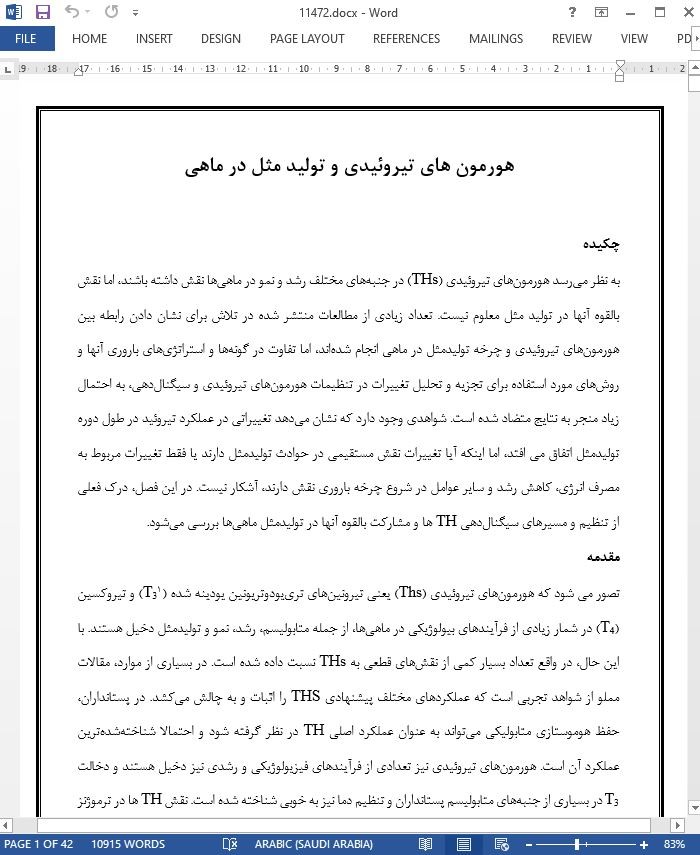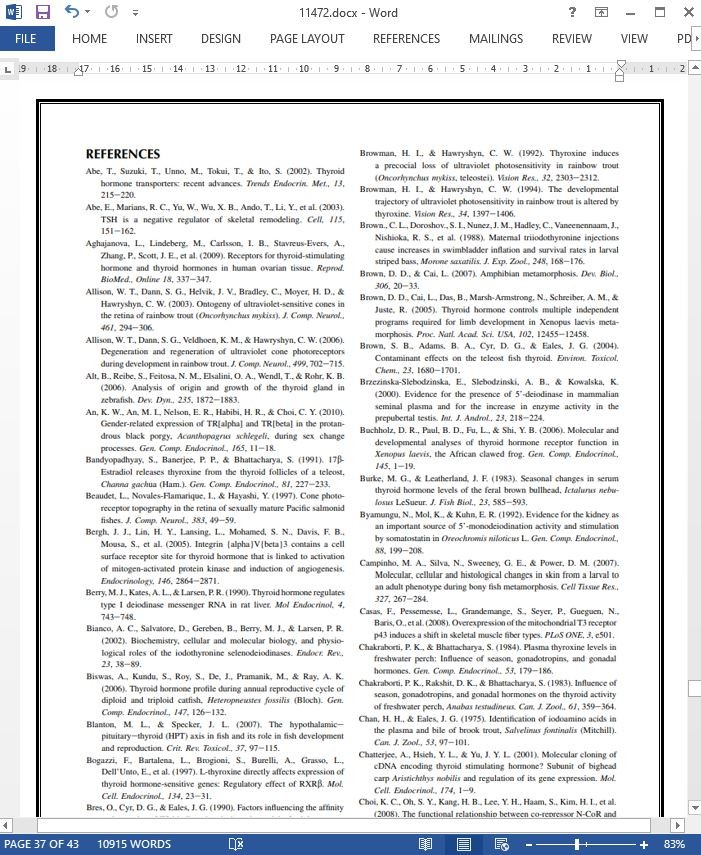
هورمون های تیروئیدی و تولید مثل در ماهی
چکیده
به نظر می رسد هورمون های تیروئیدی (THs) در جنبه های مختلف رشد و نمو در ماهی ها نقش داشته باشند، اما نقش بالقوه آنها در تولید مثل معلوم نیست. تعداد زیادی از مطالعات منتشر شده در تلاش برای نشان دادن رابطه بین هورمون های تیروئیدی و چرخه تولیدمثل در ماهی انجام شده اند، اما تفاوت در گونه ها و استراتژی های باروری آنها و روش های مورد استفاده برای تجزیه و تحلیل تغییرات در تنظیمات هورمون های تیروئیدی و سیگنال دهی، به احتمال زیاد منجر به نتایج متضاد شده است. شواهدی وجود دارد که نشان می دهد تغییراتی در عملکرد تیروئید در طول دوره تولیدمثل اتفاق می افتد، اما اینکه آیا تغییرات نقش مستقیمی در حوادث تولیدمثل دارند یا فقط تغییرات مربوط به مصرف انرژی، کاهش رشد و سایر عوامل در شروع چرخه باروری نقش دارند، آشکار نیست. در این فصل، درک فعلی از تنظیم و مسیرهای سیگنال دهی TH ها و مشارکت بالقوه آنها در تولیدمثل ماهی ها بررسی می شود.
مقدمه
تصور می شود که هورمون های تیروئیدی (Ths) یعنی تیرونین های تری یودوتریونین یودینه شده (T3 ) و تیروکسین (T4) در شمار زیادی از فرآیندهای بیولوژیکی در ماهی ها، از جمله متابولیسم، رشد، نمو و تولیدمثل دخیل هستند. با این حال، در واقع تعداد بسیار کمی از نقش های قطعی به THs نسبت داده شده است. در بسیاری از موارد، مقالات مملو از شواهد تجربی است که عملکردهای مختلف پیشنهادی THS را اثبات و به چالش می کشد. در پستانداران، حفظ هوموستازی متابولیکی می تواند به عنوان عملکرد اصلی TH در نظر گرفته شود و احتمالا شناخته شده ترین عملکرد آن است. هورمون های تیروئیدی نیز تعدادی از فرآیندهای فیزیولوژیکی و رشدی نیز دخیل هستند و دخالت T3 در بسیاری از جنبه های متابولیسم پستانداران و تنظیم دما نیز به خوبی شناخته شده است. نقش TH ها در ترموژنز احتمالا در ترکیب با اندوترمی تکامل یافته است و واضح است که ترموژنز ارتباط نزدیکی با تنظیمات متابولیکی دارد که نشان می دهد که TH ها قبل از تکامل اندوترمی در تنظیمات متابولیکی نقش داشته اند و نقش TH ها با توسعه اندوترمی تغییر کرده است. بنابراین، این احتمال وجود دارد که THs در فرآیندهای متابولیکی موجودات poikilotherms دخالت داشته باشند، حتی اگر میزان متابولیسم در این حیوانات عمدتا تحت تاثیر دمای محیط قرار گیرد. اگر چه تعدادی از مطالعات اثرات TH ها را در متابولیسم ماهی ها مطرح می کنند، شواهد به طور کلی متضاد هستند و دوزهای T4 یا T3 تجویز شده در بسیاری از این مطالعات، در محدوده فارماکولوژی قرار دارند (برای مرور به مقاله Leatherland, 1994 مراجعه کنید). با این وجود، این امکان وجود دارد که T3 نقش چندگانه ای را در تنظیمات متابولیکی ماهی ها ایفا کند، همانطور که در پستانداران نیز بدین صورت است.
Publisher Summary
Thyroid hormones (THs) appear to play a major role in vertebrate development. In particular, a large body of evidence suggests that THs are strongly associated with neural development and maturation. There is no clearly defined role for THs in reproduction, but there is evidence to suggest that THs are involved in the reproductive cycles of fishes. The strong correlation between THs and nutritional status suggests that energy partitioning plays a key role for THs during the reproductive cycle, shifting the mobilization of energy reserves from growth to reproductive maturation. There is also evidence that THs play major roles in testicular and ovarian development. However, teleosts are an incredibly large and diverse group encompassing many very different life histories and reproductive strategies, which can make interpretation and comparison between species exceedingly difficult and perhaps unrealistic.
1. INTRODUCTION
Thyroid hormones (THs), the iodinated thyronines triiodothyronine (T3) and thyroxine (T4), are thought to be involved in a large number of biological processes in fishes, including metabolism, growth, development, and reproduction. However, very few definitive roles have actually been attributed to THs. In many cases, the literature is rife with experimental evidence both substantiating and challenging various proposed functions of THs. In mammals, maintenance of metabolic homeostasis could be considered the major function of THs, and likely the best known. Thyroid hormones are also involved in a number of physiological and developmental processes, and the involvement of T3 in many aspects of mammalian metabolism and temperature regulation is well established. The role of THs in thermogenesis likely evolved in concert with endothermy, and it is evident that thermogenesis is closely tied to metabolic regulation. This suggests that THs were involved in metabolic regulation prior to the evolution of endothermy, and that the role of THs changed with the development of endothermy. Thus, there is a possibility that metabolic processes in poikilotherms involve THs, even though metabolic rates in these animals are primarily driven by ambient temperature. Although a number of studies have described effects of THs on metabolism in fishes, the evidence is generally conflicting, and the doses of T4 or T3 administered in many of these studies are in the pharmacological range (see Leatherland, 1994, for review). Nevertheless, the possibility exists that T3 plays multiple permissive roles in metabolic regulation in fishes, as it does in mammals.
چکیده
1. مقدمه
2. تحویل هورمون تيروئيدی
2.1 تنظیم سطح در چرخش هورمون تیروئیدی (TH)
2.2 ناقل های هورمون تیروئیدی (TH)
2.3- پاک شدن هورمون تیروئیدی (TH)
2.4. گیرنده های هورمون تیروئید (TH)
3. بافت تیروئید ماهی ها
3.1 سنتز و انتشار هورمون تیروئید (TH)
4. هورمون تيروئيد (TH) و تولیدمثل در ماهي ها
4.1 مطالعات پیوسته ی بررسی تغییرات عملکرد هورمون تيروئيد (TH) طی بلوغ باروری
4.2 شناسایی هورمون تیروئید (TH)
4.3. ارزیابی عملکرد تيروئيد با استفاده از تیمار استروئید جنسی
4.4 دستکاری عملکرد تيروئيد جهت ايجاد تغييرات در سيستم توليدمثل
5. نتیجه گیری
SUMMARY
1. INTRODUCTION
2. THYROID HORMONE DELIVERY
2.1. Regulation of Circulating Thyroid Hormone (TH) Levels
2.2. Thyroid Hormone (TH) Transporters
2.3. Thyroid Hormone (TH) Clearance
2.4. Thyroid Hormone (TH) Receptors
3. THE THYROID TISSUE OF FISHES
3.1. Thyroid Hormone (TH) Synthesis and Release
4. THYROID HORMONE (TH) AND REPRODUCTION IN FISHES
4.1. Correlative Studies Examining Changes in Thyroid Hormone (TH) Function During Reproductive Maturation
4.2. Identification of Thyroid Hormone (TH) Regulatory Elements in Gonadal Tissue
4.3. Assessment of Thyroid Function Using Sex Steroid Treatment
4.4. Manipulation of Thyroid Function to Induce Changes in the Reproductive System
5. CONCLUSIONS
- اصل مقاله انگلیسی با فرمت ورد (word) با قابلیت ویرایش
- ترجمه فارسی مقاله با فرمت ورد (word) با قابلیت ویرایش، بدون آرم سایت ای ترجمه
- ترجمه فارسی مقاله با فرمت pdf، بدون آرم سایت ای ترجمه



